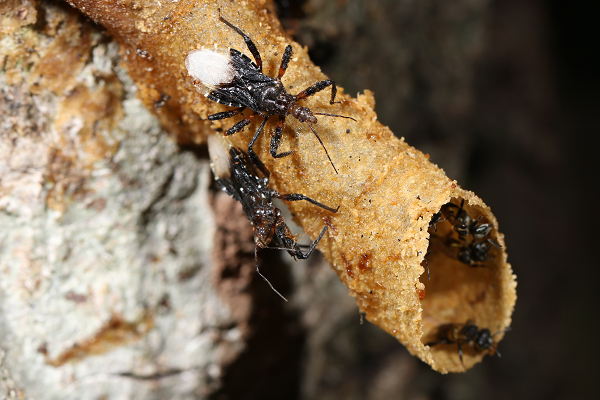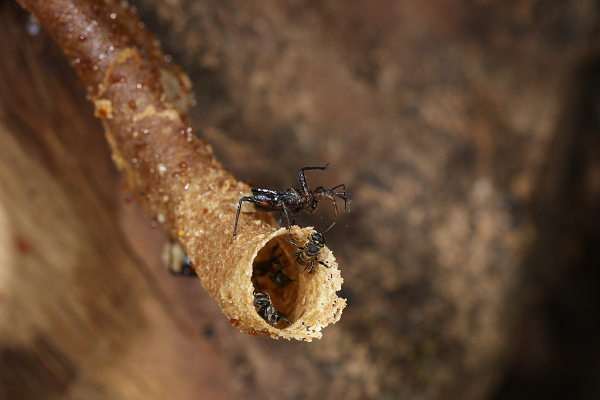Researchers have discovered a remarkable example of tool use in the insect world: the assassin bug (Pahabengkakia piliceps) weaponizes resin from stingless bee nests to trick its prey into attacking at the ideal predation part. The bugs chemically “hack” bee resin to turn colony defenses into a hunting aid. Published in PNAS, this finding provides the first comprehensive evidence of an invertebrate predator using tools to exploit the collective defenses of social insects.
The researchers from China Agricultural University, Xishuangbanna Tropical Botanical Garden (XTBG) and Institute of Zoology of the Chinese Academy of Sciences observed and documented how predatory bugs manipulate the defensive resin of stingless bees to enhance chemical signals, and how this behaviour affects bee defensive responses that the predators can use to their advantage to lure bees into their optimal hunting position.
Stingless bees deposit sticky, pungent resin around their nest entrances to deter intruders. When predators like ants or geckos become stuck, guard bees swarm to immobilize them. But the assassin bug flips this defense on its head. The researchers observed that the assassin bug deliberately collects resin with its fore- and mid legs, coats its legs, and then lures guard bees by amplifying the resin’s chemical signals. Rather than repelling the predator, the resin acts as a beacon, drawing bees into striking range.
“This is a sophisticated manipulation of prey behavior,” said WANG Zhengwei of XTBG. “The bug doesn’t just avoid detection—it actively provokes attacks to create opportunities.”
Through controlled field trials, the researchers demonstrated that resin-coated assassin bugs achieved a 75% predation success rate, compared to less than 30% for bugs without resin. Crucially, applying resin to non-hunting body parts (e.g. the abdomen) also offered relative benefit, confirming that the stickiness of the resin is not the key. Chemical analyses further revealed that the bugs’ resin handling boosted emissions of volatile compounds, making them irresistible to guard bees.
The use of tools (defensive resin of bees) by predatory bugs to improve their hunting efficiency indicates a link between tool-use behavior and dietary specialization in the animal kingdom.
“Our findings suggest that tool use can evolve under intense selective pressure, even in small-brained invertebrates,” said WANG Zhengwei of XTBG.

The bug climbing onto the stingless bee nest tube. (Image by CHEN Zhaoyang)

The bug raises its fore legs at the entrance preparing to prey. (Image by CHEN Zhaoyang)
WANG Zhengwei Ph.D
Xishuangbanna Tropical Botanical Garden, Chinese Academy of Sciences, Mengla, 666303 China
E-mail: wangzhengwei@xtbg.ac.cn
Published: 13 May 2025


